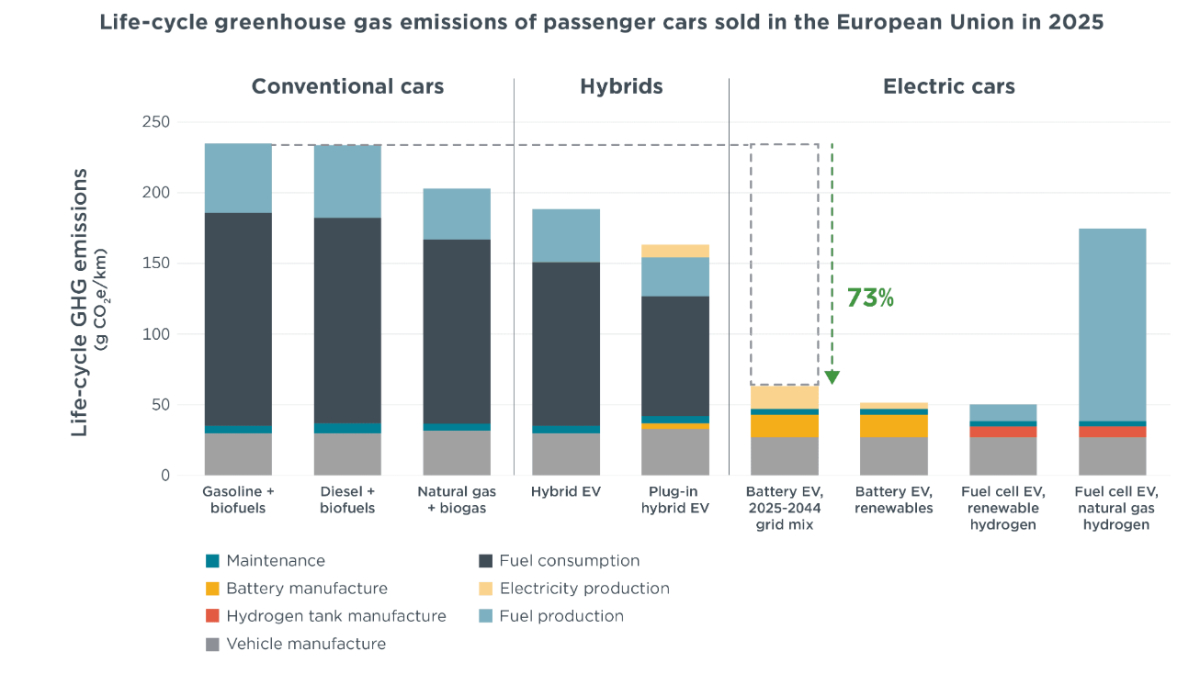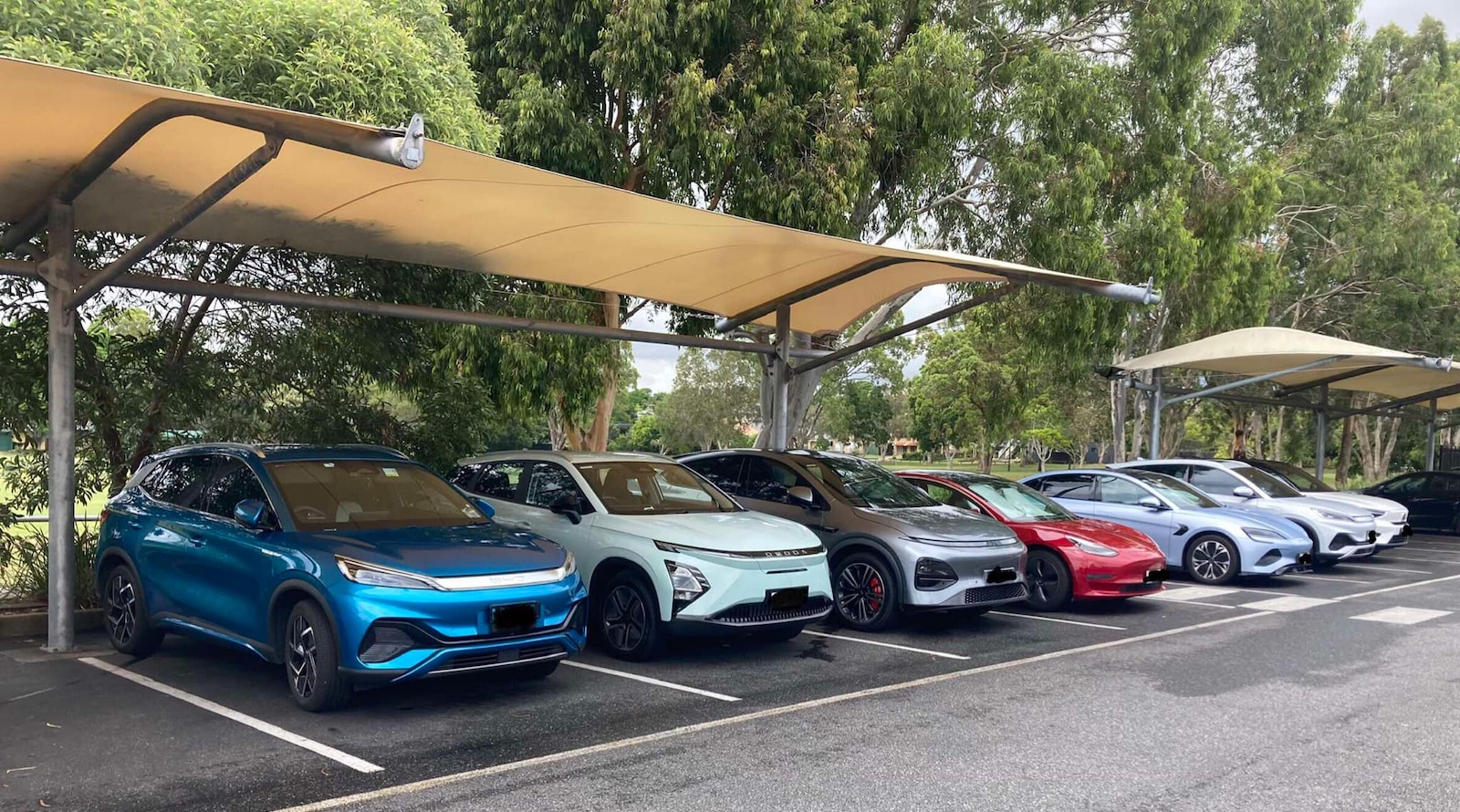The latest report from the International Council On Clean Transport (ICCT) comes to a rather startling conclusion. It finds that “battery electric cars sold today in Europe emit nearly 4 times less greenhouse gases over their lifetime than gasoline cars.” Well, that’s not exactly news to CleanTechnica readers. What is unusual is the pains the authors of the study went to in order to dispel misinformation and myths that continually swirl around electric cars.
“Misinformation and selective use of data have generated confusion regarding the climate credentials of electric cars. The ICCT analysis provides transparency on the impact of a selection of flawed assumptions, such as not accounting for the development of the grid during the lifetime of vehicles and using non-representative data on vehicle fuel consumption and lifetime.
“One common claim is that electric cars have higher emissions associated with battery manufacturing. While manufacturing emissions for battery electric cars are roughly 40% higher than for gasoline cars, the ICCT’s research shows that this initial ’emissions debt’ is typically offset after around 17,000 kilometers of driving, usually within the first one to two years of use in Europe.”
Dr. Georg Bieker, ICCT senior researcher, said: “We hope this study brings clarity to the public conversation, so that policymakers and industry leaders can make informed decisions. We’ve recently seen auto industry leaders misrepresenting the emissions math on hybrids. But life cycle analysis is not a choose-your-own-adventure exercise. Our study accounts for the most representative use cases and is grounded in real-world data. Consumers deserve accurate, science-backed information.” Wow! “A choose-your-own-adventure exercise?” That is telling it like it is, Georg. Good for you!
The report continues: “The ICCT analysis covers the greenhouse gas emissions from vehicle and battery production and recycling, fuel and electricity production, fuel consumption, and maintenance. Its methodology also accounts for the development of the electricity mix along the lifetime of vehicles, as well as real-world usage rather than official test values to estimate fuel and electricity consumption, which is key to assessing plug-in hybrid emissions.” Translation — what you are seeing is the truth, not some made-up horse puckey designed to satisfy a political agenda. Here are the results of this latest research in graphical form.

Emissions From Electric Cars Down 25 Percent
That graphic shows something that should interest advocates for electric cars. Lifetime emissions from battery electric cars have decreased by about 25 percent in the past four years. Much of that decrease is attributable to the fact that more of the electricity used to recharge those cars in Europe comes from clean energy sources today than four years ago. Sharp-eyed readers will note that the decrease in lifetime emissions from hybrid and plug-in hybrid cars has been much less.
It is true those cars may be responsible for fewer carbon emissions than conventional cars and therefore offer a benefit to society, but it is equally true that, if the objective is to reduce those emissions significantly, only battery electric cars can claim to do so. By 2025, renewable energy is expected to cover 56 percent of European electricity generation — that’s 18 percentage points higher than in 2020. The EU’s Joint Research Center predicts the share of renewables in the energy mix will increase to 86 percent by 2045.
Life Cycle Emissions Of Electric Cars
The folks at Electrive restated the concerns of the ICCT researchers in somewhat different terms. “There are numerous analyses on the ‘life cycle’ emissions of vehicles, and depending on which factors are included and how they are weighted, results vary slightly. Which emissions are counted towards production? Are the data generalised, or do they capture detailed supply chains for each component, including transport emissions? For petrol and diesel vehicles, are only tailpipe CO2 emissions counted or also those from the extraction, refining, and distribution of the fuel? And what electricity mix is used for charging EVs?”
Their commentary went on to say, “Comparing different life cycle analyses can thus be misleading due to such methodological differences. It is more meaningful to compare studies based on the same methodology but using data from different years. This is exactly what the International Council on Clean Transportation has done in its updated study.
“That study is a comprehensive life cycle analysis of all major powertrain types which reinforces earlier findings that only battery electric cars can deliver the large-scale emission cuts needed to address Europe’s most polluting transport mode. Passenger cars account for nearly three quarters of the sector’s emissions.”
“Battery electric cars in Europe are getting cleaner faster than we expected and outperform all other technologies, including hybrids and plug-in hybrids,” said Dr. Marta Negri, Researcher at the ICCT. “This progress is largely due to the fast deployment of renewable electricity across the continent and the greater energy efficiency of battery electric cars.”
Relative Emissions
Statistically, cars in Europe that run on E10 emit an average of 235 grams of CO2-equivalent per kilometer over the course of their useful life. Diesel-powered cars are slightly lower at 234 g/km, while gasoline-powered cars are at 203 g/km. EVs charged on the EU grid emit just 63 g/km, which falls to 52 g/km when using renewable electricity. Hybrids, on average, emit 188 g/km, while plug-in hybrids are slightly lower at 163 g/km because they rely mostly on their onboard gasoline engines. “Even with greater use of biofuels, no significant improvement is expected for combustion or hybrid vehicles,” the ICCT report says.
“Battery electric cars in Europe are getting cleaner faster than we expected and outperform all other technologies, including hybrids and plug-in hybrids,” said Marta Negri, a co-author of the study. “This progress is largely due to the fast deployment of renewable electricity across the continent and the greater energy efficiency of battery electric cars.”
Battery chemistry also has an effect on lifetime emissions numbers. Today, the default battery in an electric car in Europe uses NMC622 cells, which served as the study’s baseline. NMC622 cells offer a slight improvement, while LFP battery cells have a significantly lower carbon footprint. As LFP batteries become more widely used in European EVs, that will help lower lifetime emissions even more.
When the ICCT compared its findings to official figures, it found that WLTP data understated combustion emissions by around 10 percent. By contrast, WLTP data shows EV emissions are 25 to 64 percent higher that what the researchers calculated, which makes the apparent emissions advantage smaller than it actually is. The ICCT study focuses on realistic data to provide a more relevant assessment.
“We hope this study brings clarity to the public conversation, so that policymakers and industry leaders can make informed decisions,” said Bieker. The final conclusion of the ICCT research is unambiguous. “Our findings support the following policy considerations: The phaseout of new ICEV, HEV, and PHEV registrations by 2035 would align sector emissions with EU climate targets.” No ifs, ands, or buts about that.
Sign up for CleanTechnica’s Weekly Substack for Zach and Scott’s in-depth analyses and high level summaries, sign up for our daily newsletter, and follow us on Google News!
Whether you have solar power or not, please complete our latest solar power survey.
Have a tip for CleanTechnica? Want to advertise? Want to suggest a guest for our CleanTech Talk podcast? Contact us here.
Sign up for our daily newsletter for 15 new cleantech stories a day. Or sign up for our weekly one on top stories of the week if daily is too frequent.
CleanTechnica uses affiliate links. See our policy here.
CleanTechnica’s Comment Policy

